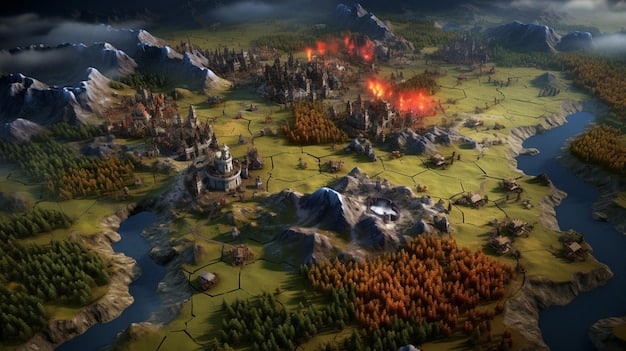Are the 3 Most Anticipated Video Game Releases Worth the Hype?

The gaming world is buzzing with anticipation for three major video game releases in the next six months, each promising groundbreaking experiences and pushing technological boundaries; evaluating their potential requires a deep dive into developer reputation, gameplay innovation, and community expectations to discern if they will truly live up to the immense hype.
In the dynamic realm of video games, few topics ignite as much passion and debate as upcoming releases. The promise of new worlds, innovative mechanics, and compelling narratives keeps millions of players on the edge of their seats. This article delves into the burning question: Alert: The 3 Most Anticipated Video Game Releases of the Next 6 Months – Are They Worth the Hype? We’ll dissect the buzz, scrutinize the promises, and offer an informed perspective on whether these titles are poised to redefine gaming or merely ride a wave of inflated expectations.
Understanding the Hype Machine: How Anticipation Builds
The journey from a game’s announcement to its release is often a masterclass in marketing and community engagement. Developers and publishers meticulously craft narratives around their upcoming titles, teasing features, showcasing stunning visuals, and sharing snippets of gameplay. This carefully orchestrated unveiling process is designed to build immense anticipation, fostering a sense of shared excitement among players globally.
However, this “hype machine” is a double-edged sword. While it generates vital interest and pre-orders, it also sets extraordinarily high expectations. Players often project their ideal game onto these nascent titles, sometimes overlooking potential limitations or challenges in development. Understanding the components of this hype is crucial before assessing whether any game can truly live up to it.
The pillars of pre-release excitement
- Developer pedigree: A studio’s track record plays a significant role. If a developer has a history of delivering high-quality, innovative games, expectations for their next project naturally soar. This trust is built over years of consistent performance and community interaction.
- Innovative gameplay promises: Announcing unique mechanics, revolutionary graphics, or never-before-seen narrative structures can instantly capture attention. These promises often become the focal point of discussions and speculation, driving fan engagement.
- Marketing & community engagement: Strategic reveals, cinematic trailers, developer diaries, and active presence on social media platforms keep the game in the public eye. Influencers and content creators also amplify the messaging, further spreading awareness and excitement.
Furthermore, the gaming press and content creators play a vital role in shaping public perception. Early access previews, detailed analyses of trailers, and interviews with developers feed into the ongoing dialogue. This collective enthusiasm, while organic in many ways, can also amplify minor details into monumental expectations, making the final release a precarious balance act between satisfying the actual product and the imagined one.
The challenge for developers then becomes not just delivering a good game, but one that aligns with the often-unrealistic collective vision fostered by months or even years of intense speculation. This is why a critical, informed perspective is essential when evaluating whether a title is genuinely worth the hype it has generated.

Game 1: Chronicle of the Verdant Veil – A Deep Dive
Our first contender is Chronicle of the Verdant Veil, an ambitious open-world RPG that has swiftly climbed the ranks of most anticipated titles. Developed by Aurora Studios, known for their critically acclaimed “Astral Echoes” series, this game promises a sprawling, dynamic world brimming with untold stories and unique creatures. The initial reveal trailer showcased stunning environmental fidelity and intricate character designs, immediately setting a high bar for visual immersion.
The core appeal of Chronicle of the Verdant Veil lies in its emphasis on player agency and narrative branching. Aurora Studios has hinted at a procedural storytelling system, where player choices significantly alter the game world and its inhabitants. This contrasts with more linear RPG experiences and aims to offer unparalleled replayability. The combat system, described as a blend of real-time action and tactical pause, also offers a fresh take on the genre’s familiar mechanics.
Promises and potential pitfalls
- Dynamic world simulation: The promise of a truly reactive world is enticing, but often challenging to implement without feeling artificial. Will the AI truly adapt, or will it fall into predictable patterns?
- Narrative complexity: Branching narratives are laudable, but maintaining coherence and impact across multiple storylines requires exceptional writing and technical prowess. There’s a risk of feeling too disjointed or having too many “dead ends.”
- Technical performance: An open world of this purported scale and detail will demand significant optimization. Previous large-scale RPGs have often launched with performance issues, a concern that shadows even the most promising titles.
Interviews with the development team reveal a passionate commitment to these ambitious goals. They have detailed their proprietary engine, “Luminescent Engine 3.0,” claiming it can handle the complexity without compromising performance. However, skepticism remains, particularly concerning the procedural narrative. While the concept is revolutionary, past attempts in other games have sometimes felt repetitive or lacked true depth.
From a gameplay perspective, the tactical combat seems refined and offers a satisfying learning curve. Early impressions from limited press playtests suggest a strong foundation. However, these are often curated experiences. The real test will be how well these systems hold up over dozens, if not hundreds, of hours of gameplay. Ultimately, Chronicle of the Verdant Veil carries tremendous potential, but its ability to fully deliver on its loftiest promises will dictate whether it transcends mere hype to become a genre-defining experience.
Game 2: Echoes of the Quantum Realm – Redefining Sci-Fi
Next on our radar is Echoes of the Quantum Realm, a first-person shooter (FPS) that promises to fuse exhilarating gunplay with mind-bending narrative elements inspired by quantum physics. Developed by Genesis Games, a studio renowned for their atmospheric narrative titles, this project represents a significant departure from their previous work, venturing into a more action-oriented genre while retaining their signature storytelling depth. The game’s unique selling proposition is its “Reality Shift” mechanic, allowing players to manipulate the very fabric of space and time to solve puzzles and overcome combat scenarios.
Early trailers for Echoes of the Quantum Realm have captivated audiences with their enigmatic visuals and intriguing premise. The art style is a blend of cyberpunk aesthetics and bizarre, otherworldly landscapes, suggesting a game that prioritizes environmental storytelling and psychological elements. The combat, while fast-paced, appears to demand strategic use of the “Reality Shift” ability, moving beyond typical run-and-gun mechanics.
Innovation vs. execution
- Quantum mechanics in gameplay: Integrating complex scientific theories into intuitive gameplay is a formidable challenge. The risk is either oversimplifying the mechanics to the point of triviality or making them too abstract for the average player.
- Narrative coherence: A “mind-bending” plot can easily devolve into confusion if not meticulously crafted. Genesis Games has a strong narrative history, but a sci-fi concept of this magnitude requires exceptional clarity amid complexity.
- Multiplayer integration: While primarily a single-player experience, hints of competitive or cooperative elements raise questions about how the core “Reality Shift” mechanic will translate into a balanced multiplayer environment.
The developers have spoken at length about their collaboration with theoretical physicists to ensure a semblance of scientific accuracy within the game’s fantastical framework. This dedication to detail is commendable and adds to the game’s allure. Nevertheless, the ultimate success of Echoes of the Quantum Realm hinges on the seamless integration of these ambitious concepts into a cohesive and enjoyable gameplay loop.
First impressions of the “Reality Shift” mechanic suggest a significant learning curve, but one that promises deep strategic possibilities. It’s not merely a gimmick; it appears to be central to both puzzle-solving and combat. However, the true test will be its variety and how well it avoids repetition over the course of a full campaign. If Genesis Games can effectively balance its ambitious sci-fi narrative with compelling and intuitive gameplay, Echoes of the Quantum Realm could indeed redefine its genre, proving itself worthy of the considerable hype.
Game 3: The Last Stand of Aethelred – A Strategy Masterpiece?
Rounding out our trio of highly anticipated titles is The Last Stand of Aethelred, a real-time strategy (RTS) game set in a grimdark fantasy world. Developed by Ironclad Games, a studio celebrated for its tactical depth and innovative unit design in previous RTS outings, this game aims to rekindle interest in a genre that has seen fluctuating fortunes. The game promises massive, epic battles with thousands of units on screen, coupled with deep economic and base-building mechanics.
What differentiates The Last Stand of Aethelred from its peers is its focus on asymmetrical factions. Each of the four factions boasts entirely unique units, abilities, and economic structures, demanding diverse strategies from players. This design philosophy promises high replayability and a rich competitive scene. Visually, the game features a dark, gritty aesthetic, with highly detailed unit models and environmental effects, aiming for a cinematic battle experience.
RTS revival: challenges and opportunities
- Balance and asymmetry: Designing perfectly balanced asymmetrical factions is notoriously difficult. Developers face the constant challenge of ensuring each faction feels distinct but equally viable in competitive play.
- Accessibility vs. depth: RTS games can be intimidating for newcomers due to their complexity. Ironclad Games needs to strike a balance between offering strategic depth for veterans and an accessible entry point for new players.
- Performance for scale: Rendering thousands of individual units with complex AI in real-time is a significant technical hurdle. Maintaining stable frame rates, especially during large-scale engagements, is paramount for player enjoyment.
Ironclad Games has expressed a clear commitment to supporting The Last Stand of Aethelred post-launch with ongoing balance patches, new content, and a robust esports infrastructure. This long-term vision is crucial for any competitive RTS game. They’ve also implemented a new “Dynamic Frontline” system, which reportedly allows for more fluid and realistic battle lines, rather than rigid, static formations.
Beta feedback for The Last Stand of Aethelred has been largely positive, praising the distinct feel of each faction and the satisfaction of commanding large armies. Concerns, however, revolve around the potential for “meta” strategies to emerge too quickly and dominate the competitive scene, and the initial learning curve that might deter casual players. If Ironclad Games can maintain careful balance and continuously evolve the game, The Last Stand of Aethelred has the potential to become a true RTS landmark, living up to the considerable anticipation from strategy enthusiasts.

The Science of Hype vs. Reality: Managing Expectations
The gap between pre-release hype and the reality of a launched game is a constantly discussed topic within the gaming community. Developers, publishers, and players all play a role in this delicate balance. From the developer’s side, there’s an inherent tension between generating excitement to secure investment and pre-orders, and making promises they can truly deliver on within budget and timeline constraints. Over-promising can lead to severe backlash and a damaged reputation, as seen with several high-profile releases in recent years.
Players, on the other hand, often amplify excitement through speculation and personal desires, sometimes creating an idealized version of the game that no developer could realistically achieve. This isn’t malice, but rather the natural human tendency to project hopes onto an exciting unknown. The cumulative effect of this collective imagination can sometimes result in expectations that are simply impossible to meet, regardless of the game’s actual quality.
Strategies for informed anticipation
- Scrutinize gameplay footage: Look past the cinematic trailers. Seek out raw gameplay demonstrations, developer livestreams, and independent previews. These offer a more realistic glimpse into the actual mechanics and visual fidelity.
- Research developer history: A studio’s past projects are strong indicators of their capabilities and common pitfalls. Do they consistently deliver on promises? Are their games typically polished at launch?
- Engage with diverse opinions: Don’t rely solely on highly positive or negative takes. Read reviews from multiple sources, watch different content creators, and engage in community discussions to get a balanced perspective.
It’s also crucial to remember that game development is an incredibly complex process. Technical challenges, creative shifts, and unforeseen delays are common. What is shown years before release might genuinely be the developer’s vision at that moment, but it can evolve significantly before the final product ships. Consumers, therefore, must adapt a degree of informed skepticism. This means tempering enthusiasm with a critical eye, understanding that even the most promising games face hurdles.
Ultimately, a game being “worth the hype” is a subjective measure. For some, it means exceeding all expectations. For others, it’s about delivering a solid experience without major flaws. By adopting a more analytical approach to pre-release information, players can better manage their own expectations and avoid potential disappointment, ensuring a more enjoyable experience regardless of a game’s pre-release narrative.
Post-Launch Realities: Day One Patches and Live Service Models
The traditional notion of a game being “complete” at launch has largely faded, replaced by a reality defined by day-one patches, ongoing updates, and often, live service models. This shift profoundly impacts whether a highly anticipated game is “worth the hype” not just at release, but months or even years down the line. A game that launches with technical issues but has strong post-launch support can eventually overcome a rocky debut, while a seemingly polished game that lacks continued attention might fade quickly.
Day-one patches have become almost expected, addressing critical bugs and performance issues discovered after the “gold master” version is sent for mass production. While sometimes frustrating, these patches are often necessary fixes for complex software. The real concern arises when fundamental design flaws or significant content gaps are evident, suggesting a rushed release rather than minor polish needs.
The evolving game landscape
- Content roadmaps: Many developers now share post-launch content plans (DLC, expansions, seasonal updates) even before release. This can extend a game’s value but also puts pressure on early adopters to trust in promised future content.
- Community feedback loops: Successful live service games actively incorporate player feedback into their development cycles. This continuous iteration can improve a game significantly over time, but requires a dedicated development team and open communication.
- Monetization strategies: Microtransactions, battle passes, and cosmetic shops are increasingly common. While some are purely optional, others can influence perceived value and player satisfaction, impacting the long-term “worth” of a game.
The success of live service models depends heavily on a game’s ability to maintain player engagement over time, often relying on a steady stream of new content, competitive balance, and community events. This transforms the initial hype from a singular event into a continuous obligation for developers to keep proving their game’s value. For players, it means evaluating not just the initial offering, but the long-term commitment of the developers.
Consider games like No Man’s Sky, which launched to widespread criticism for failing to deliver on its ambitious promises, but redeemed itself through years of free, substantial updates. Conversely, titles that launched strongly but lacked ongoing support have often seen their player bases dwindle. Therefore, when assessing whether the three anticipated titles are truly “worth the hype,” it’s vital to consider not just their launch state, but the developers’ demonstrated commitment to their longevity and evolution in the ever-changing gaming ecosystem.
Beyond the Headlines: The Long-Term Impact and Player Experience
The true measure of a game’s worth extends far beyond its initial sales figures or review scores; it lies in its long-term impact and the sustained player experience. A game that is “worth the hype” fundamentally reshapes player expectations, influences industry trends, and fosters a lasting community. This goes beyond technical prowess or narrative complexity, delving into how a game resonates with its audience and inspires future titles.
For the three games we’ve discussed—Chronicle of the Verdant Veil, Echoes of the Quantum Realm, and The Last Stand of Aethelred—their ultimate legacy will be determined by how they endure over time. Will they be remembered as fleeting sensations, or as benchmarks for their respective genres? This involves examining factors such as ongoing community engagement, critical reception post-launch, and their influence on game design paradigms.
Defining lasting impact
- Community longevity: A vibrant and active player base, years after release, is a strong indicator of a game’s enduring appeal. This is often fostered by robust multiplayer modes, modding support, or a strong single-player replayability loop.
- Influence on industry: Games that introduce truly innovative mechanics or narrative techniques can inspire other developers, leading to a broader shift in game design. This meta-impact is a significant part of a game’s legacy.
- Critical re-evaluation: Sometimes, a game’s true genius isn’t recognized at launch, but appreciates over time as its concepts mature or the community discovers new ways to experience it. This re-evaluation often solidifies its place in history.
The narrative around a game often evolves significantly after its release. Initial reactions, driven by hype or disappointment, can give way to a more nuanced appreciation (or critique) as players delve deeper into its systems and content. A game that prioritizes player experience—focusing on fluid controls, compelling progression, fair monetization, and robust support—is more likely to achieve lasting success.
Ultimately, whether these highly anticipated releases are “worth the hype” will depend on their ability to deliver not just technically sound experiences, but genuinely memorable and impactful ones that resonate deeply with players and potentially influence the future direction of interactive entertainment. It’s a journey from initial excitement to sustained legacy, and only time will tell how each of these titles fares.
| Key Aspect | Brief Description |
|---|---|
| ✨ Hype Factors | Developer legacy, innovative mechanics, and strong marketing build pre-release excitement. |
| 🎮 Game Variety | Upcoming titles span open-world RPG, sci-fi FPS, and real-time strategy genres. |
| ⚠️ Risk vs. Reward | Ambitious promises face challenges in technical execution, balance, and long-term engagement. |
| 📈 Post-Launch | Ongoing updates, community support, and content roadmaps are crucial for sustained success. |
Frequently Asked Questions About Game Releases
▼
The biggest drivers of hype are usually a developer’s strong track record, promises of innovative gameplay mechanics, visually stunning trailers, and consistent, engaging marketing campaigns. Player anticipation also builds through community discussion and speculation about potential features.
▼
Players should look beyond cinematic trailers and seek out raw gameplay footage, developer interviews, and independent previews. Researching the developer’s past projects and considering diverse opinions from various media outlets can also provide a more balanced perspective on a game’s potential.
▼
Common pitfalls include unfulfilled promises regarding core gameplay or features, significant technical issues at launch (bugs, performance problems), and a lack of compelling content depth. Over-promising by developers and inflated player expectations also frequently contribute to disappointment.
▼
They can be both. Day-one patches can fix critical issues, improving the initial experience. Live service models, with ongoing content and support, can extend a game’s longevity. However, they can be detrimental if a game launches with major flaws relying too heavily on future fixes, or if monetization practices are predatory.
▼
A game’s long-term impact is arguably more important. While initial reception drives sales, sustained player engagement, community longevity, and influence on future industry trends truly define a game’s success and legacy. Many games initially criticized have become beloved classics through continuous improvement and dedicated community support.
Conclusion
The journey of a video game from concept to release, and beyond, is fraught with anticipation, innovation, and immense technical challenges. For Chronicle of the Verdant Veil, Echoes of the Quantum Realm, and The Last Stand of Aethelred, the next six months will be pivotal in determining if they can truly live up to the gargantuan expectations they’ve fostered. While each title brings unique promises and builds upon established genre tropes, their ultimate “worth” will hinge on a delicate balance of delivering on their ambitious visions, ensuring technical polish, and fostering a dedicated community. As discerning players, our role remains to approach these anticipated releases with a blend of enthusiasm and informed skepticism, allowing the games themselves, rather than merely the hype, to speak volumes.





